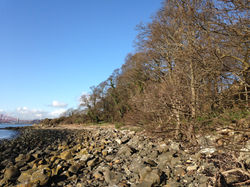January in The Bay
So, after a mild November and December, winter finally gave us a few days to taste what the season can bring. But despite cold winds and ice on the ponds, day-length is now on the increase and wildlife is already responding. The snowdrops in Bathing House Wood are almost fully open and bluebells are beginning to push through the litter of leaves and autumn debris.
With no leaves on the trees this is a good time to see birds in the woodlands, and on any walk through the woods there are usually quite a number of Blackbirds to be seen, feathers puffed out to insulate them from the cold. Some are already beginning to stake out, or reclaim, potential territories, but several of those you may see are not our locals and will soon be winging their way back to Scandinavia. They have migrated here to spend their winter in our milder climate.
Robins too are often out and about, ever watchful for food, potential predators, or a competitor for territory, and if you see two it is often in a flurry of wings and fast aerobatics as they settle a territorial dispute.
Winter here can be a hard time for some birds, and wrens are especially vulnerable to cold conditions; a particularly severe winter can see their populations crash. But our woods have a good number that have come through our, so far, relatively mild conditions. They are not always easy to see as they move very fast and often all you notice is a flicker of brown as they disappear into the habitat piles, or round tree branches, in search of insects and spiders. But keep looking where you last saw them and you may get a longer view of this energetic little bird, tail up, that will soon be heralding spring with its vigorous song.
For those with bird feeders you will always be guaranteed to see more birds than on a walk through the woods, but look carefully at some of your visitors as sometimes what may appear to be a common bird could be something else. We are all used to seeing House Sparrows, though even they are not as abundant as they once were, but look carefully and you may be lucky enough to see a less common relative, the Tree Sparrow. If you see a dark patch on the white cheeks and the chestnut brown as opposed to grey head colouring you will be looking at a Tree Sparrow. While this species is much less likely to be seen in gardens than the House Sparrow, there are some being seen in the area at present and, unlike the House Sparrow whose numbers have experienced a steady decline in recent years, their numbers have remained low but steady.
For those with an interest in birds however our coastal waters always have something to see and this is especially true at this time of year.
The shoreline of the Forth provides fishing for the hook billed Shag as it cruises along the shallows.
Or rests up on a weed coated rock.
But at this time of year our resident birds are joined by a host of winter visitors, or others which are just passing through. Many feed on the mud flats of Dalgety Bay itself but at high tide they have to cease feeding and find somewhere to rest up before the tide falls again and they can return to the search for their seafood diet.
The familiar Oystercatcher and often noisy Redshank wait on convenient, almost dry, rocks.
Others have been using the old pier beside the Sailing Club to wait the turn of the tide.
Here a small flock of Dunlin join more of their species along with a few Oystercatchers and Ringed Plovers.
High spring tides do however have their advantages for other birds. The inner bay at this time of year is home for small numbers of Wigeon, a duck that winters in coastal areas, and ours may have come from populations that breed in Iceland, Scandinavia or Russia. At the top of spring tides the rising waters float off the piles of seaweed and other debris washed up by earlier storms. These have provided food and shelter for a wide range of insects and other invertebrates which normally remain hidden underneath, but when they float free on the high tide the various invertebrates become welcome food for these winter visitors.
They may not always be clearly seen among the flocks of other seabirds, but they will certainly be heard, the whistling call of the males is very distinctive and these birds are now showing off their smart breeding plumage which shows to perfection when the sun catches it.
There are also other interesting birds finding a convenient place to rest up in our sheltered waters. Goldeneye can be seen on the water, not yet in breeding plumage, and, at too great a distance for a good photo, a Bar-tailed Godwit feeding on the mud of the bay beside Bathing House Wood.
The woodlands of Dalgety Bay may not yet be bursting with springtime life, but the signs of change are there and there is still plenty to see on a wander along the Coastal Path, both in the woods and on the water. So go out with a pair of binoculars, especially as high tide approaches, and enjoy a wildlife spectacle. It won’t be too long before our winter visitors will be heading north to their summer breeding grounds. But try not to disturb them; if they fly off to avoid people or dogs they are using stored energy that they need to fly back to their summer haunts; journeys that may be a few hundred to a few thousand miles.
Dick Alderson
23 January 2015







































